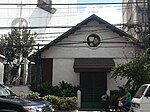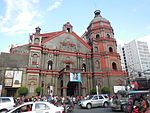Lucky Chinatown

Lucky Chinatown (Chinese: 美加廣場; pinyin: Měijiā guǎngchǎng; Pe̍h-ōe-jī: Bí-ka kńg-tiûⁿ) is a lifestyle mall development of Megaworld Lifestyle Malls located along Reina Regente Street corner Dela Reina Street in Binondo, Manila.Awarded the Shopping Center of the Year by the Philippine Retailers Association in 2015, Lucky Chinatown is the first full-scale lifestyle mall in the world’s oldest Chinatown. It is designed to offer a blend of history, tradition and modern shopping, dining and leisure experience. The four-level, 108,000-square-metre (1,160,000 sq ft) shopping mall is envisioned as a heritage project that promotes Binondo’s tradition of commerce and tourism during modern times.
Excerpt from the Wikipedia article Lucky Chinatown (License: CC BY-SA 3.0, Authors, Images).Lucky Chinatown
Reina Regente Street, Manila Binondo (Third District)
Geographical coordinates (GPS) Address Website External links Nearby Places Show on map
Geographical coordinates (GPS)
| Latitude | Longitude |
|---|---|
| N 14.60356 ° | E 120.97358 ° |
Address
Lucky Chinatown
Reina Regente Street
1006 Manila, Binondo (Third District)
Philippines
Open on Google Maps







